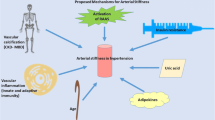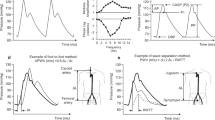Abstract
Central blood pressure is dependent on the stiffness of large arteries and pulse wave reflection. These parameters are very important in the development of hypertensive target organ disease. Moreover, recent clinical studies have shown their independent predictive value for cardiovascular morbidity and mortality. Therefore, 2007 guidelines for the management of hypertension inserted the evaluation of central arterial stiffness as an important component for assessing total cardiovascular risk. Differences in the way various antihypertensive drugs affect arterial stiffness and central hemodynamics may explain the greater cardiovascular protection provided by newer drugs (eg, renin-angiotensin system blockers or calcium channel blockers) independent of peripheral blood pressure reduction, as shown by recent clinical studies. However, the predictive value of the attenuation of arterial stiffness, wave reflections, and central blood pressure still needs to be confirmed in prospective, long-term, large-scale therapeutic trials. Thus, whether these measurements should be routinely performed as a diagnostic or therapeutic indicator remains debatable.
Similar content being viewed by others
References and Recommended Reading
Mancia G, De Backer G, Dominiczak A, et al.: 2007 Guidelines for the Management of Arterial Hypertension: The Task Force for the Management of Arterial Hypertension of the European Society of Hypertension (ESH) and of the European Society of Cardiology (ESC). J Hypertens 2007, 25:1105–1187.
Lewington S, Clarke R, Qizilbash N, et al.: Age-specific relevance of usual blood pressure to vascular mortality: a meta-analysis of individual data for one million adults in 61 prospective studies. Lancet 2002, 360:1903–1913.
Turnbull F: Effects of different blood-pressure-lowering regimens on major cardiovascular events: results of prospectively-designed overviews of randomised trials. Lancet 2003, 362:1527–1535.
Staessen JA, Li Y, Thijs L, Wang JG: Blood pressure reduction and cardiovascular prevention: an update including the 2003–2004 secondary prevention trials. Hypertens Res 2005, 28:385–407.
Salvetti A, Ghiadoni L: Guidelines for antihypertensive treatment: an update after the ALLHAT study. J Am Soc Nephrol 2004, 15:S51–S54.
Laurent S, Cockcroft J, Van Bortel L, et al.: Expert consensus document on arterial stiffness: methodological issues and clinical applications. Eur Heart J 2006, 27:2588–2605.
Nichols WW, O’Rourke MF: McDonald’s Blood Flow in Arteries: Theoretical, Experimental and Clinical Principles, edn 5. New York: Oxford University Press; 2005:624.
Oparil S, Izzo JL Jr: Pulsology rediscovered: commentary on the Conduit Artery Function Evaluation (CAFE) study. Circulation 2006, 113:1162–1163.
Dahlof B, Devereux RB, Kjeldsen SE, et al.: Cardiovascular morbidity and mortality in the Losartan Intervention For Endpoint reduction in hypertension study (LIFE): a randomised trial against atenolol. Lancet 2002, 359:995–1003.
Dahlöf B, Sever PS, Poulter NR, et al.: Prevention of cardiovascular events with an antihypertensive regimen of amlodipine adding perindopril as required versus atenolol adding bendroflumethiazide as required, in the Anglo-Scandinavian Cardiac Outcomes Trial-Blood Pressure Lowering Arm (ASCOT-BPLA): a multicentre randomised controlled trial. Lancet 2005, 366:895–906.
Kaplan NM, Opie LH: Controversies in hypertension. Lancet 2006, 367:168–176.
Giannattasio C, Failla M, Lucchina S, et al.: Arterial stiffening influence of sympathetic nerve activity: evidence from hand transplantation in humans. Hypertension 2005, 45:608–611.
Giannattasio C, Failla M, Stella ML, et al.: Angiotensin-converting enzyme inhibition and radial artery compliance in patients with congestive heart failure. Hypertension 1995, 26:491–496.
Safar ME, Levy BI, Struijker-Boudier H: Current perspectives on arterial stiffness and pulse pressure in hypertension and cardiovascular diseases. Circulation 2003, 107:2864–2869.
Laurent S, Boutouyrie P: Recent advances in arterial stiffness and wave reflection in human hypertension. Hypertension 2007, 49:1202–1206.
Izzo JL Jr: Arterial stiffness and the systolic hypertension syndrome. Curr Opin Cardiol 2004, 19:341–352.
O’Rourke MF, Adji A: An updated clinical primer on large artery mechanics: implications of pulse waveform analysis and arterial tonometry. Curr Opin Cardiol 2005, 20:275–281.
Mitchell GF, Parise H, Benjamin EJ, et al.: Changes in arterial stiffness and wave reflection with advancing age in healthy men and women: the Framingham Heart Study. Hypertension 2004, 43:1239–1245.
Nichols WW, Singh BM: Augmentation index as a measure of peripheral vascular disease state. Curr Opin Cardiol 2002, 17:543–551.
O’Rourke MF, Staessen JA, Vlachopoulos C, et al.: Clinical applications of arterial stiffness; definitions and reference values. Am J Hypertens 2002, 15:426–444.
Swillens A, Segers P: Assessment of arterial pressure wave reflection: methodological considerations. Artery Res 2008, 2:122–131.
Papaioannou TG, Lekakis JP, Karatzis EN, et al.: Transmission of calibration errors (input) by generalized transfer functions to the aortic pressures (output) at different hemodynamic states. Int J Cardiol 2006, 110:46–52.
Wilkinson IB, Mohammad NH, Tyrrell S, et al.: Heart rate dependency of pulse pressure amplification and arterial stiffness. Am J Hypertens 2002, 15:24–30.
McEniery CM, Yasmin, Hall IR, et al.: Normal vascular aging: differential effects on wave reflection and aortic pulse wave velocity: the Anglo-Cardiff Collaborative Trial (ACCT). J Am Coll Cardiol 2005, 46:1753–1760.
Shorr RI, Somes GW: Can diastolic blood pressure be excessively lowered in the treatment of isolated systolic hypertension? J Clin Hypertens (Greenwich) 2000, 2:134–137.
Saeki A, Recchia F, Kass DA: Systolic flow augmentation in hearts ejecting into a model of stiff aging vasculature. Influence on myocardial perfusion-demand balance. Circ Res 1995, 76:132–141.
Chemla D, Nitenberg A, Teboul JL, et al.: Subendocardial viability index is related to the diastolic/systolic time ratio and left ventricular filling pressure, not to aortic pressure: an invasive study in resting humans. Clin Exp Pharmacol Physiol 2008 Nov 7 (Epub ahead of print).
Schwartzkopff B, Motz W, Frenzel H, et al.: Structural and functional alterations of the intramyocardial coronary arterioles in patients with arterial hypertension. Circulation 1993, 88:993–1003.
O’Rourke MF, Safar ME: Relationship between aortic stiffening and microvascular disease in brain and kidney: cause and logic of therapy. Hypertension 2005, 46:200–204.
Laurent S, Boutouyrie P, Lacolley P: Structural and genetic bases of arterial stiffness. Hypertension 2005, 45:1050–1055.
Boutouyrie P, Tropeano AI, Asmar R, et al.: Aortic stiffness is an independent predictor of primary coronary events in hypertensive patients: a longitudinal study. Hypertension 2002, 39:10–15.
Leone N, Ducimetiere P, Gariepy J, et al.: Distension of the carotid artery and risk of coronary events: the three-city study. Arterioscler Thromb Vasc Biol 2008, 28:1392–1397.
Watabe D, Hashimoto J, Hatanaka R, et al.: Electrocardiographic left ventricular hypertrophy and arterial stiffness: the Ohasama study. Am J Hypertens 2006, 19:1199–1205.
Hermans MM, Henry R, Dekker JM, et al.: Estimated glomerular filtration rate and urinary albumin excretion are independently associated with greater arterial stiffness: the Hoorn Study. J Am Soc Nephrol 2007, 18:1942–1952.
London GM, Blacher J, Pannier B, et al.: Arterial wave reflections and survival in end-stage renal failure. Hypertension 2001, 38:434–438.
Safar ME, Blacher J, Pannier B, et al.: Central pulse pressure and mortality in end-stage renal disease. Hypertension 2002, 39:735–738.
Weber T, Auer J, O’Rourke MF, et al.: Increased arterial wave reflections predict severe cardiovascular events in patients undergoing percutaneous coronary interventions. Eur Heart J 2005, 26:2657–2663.
Williams B, Lacy PS, Thom SM, et al.: Differential impact of blood pressure-lowering drugs on central aortic pressure and clinical outcomes: principal results of the Conduit Artery Function Evaluation (CAFE) study. Circulation 2006, 113:1213–1225.
Chirinos JA, Zambrano JP, Chakko S, et al.: Aortic pressure augmentation predicts adverse cardiovascular events in patients with established coronary artery disease. Hypertension 2005, 45:980–985.
Roman MJ, Devereux RB, Kizer JR, et al.: Central pressure more strongly relates to vascular disease and outcome than does brachial pressure: the Strong Heart Study. Hypertension 2007, 50:197–203.
Pini R, Cavallini MC, Palmieri V, et al.: Central but not brachial blood pressure predicts cardiovascular events in an unselected geriatric population: the ICARe Dicomano Study. J Am Coll Cardiol 2008, 51:2432–2439.
Dart AM, Gatzka CD, Kingwell BA, et al.: Brachial blood pressure but not carotid arterial waveforms predict cardiovascular events in elderly female hypertensives. Hypertension 2006, 47:785–790.
Guerin AP, Blacher J, Pannier B, et al.: Impact of aortic stiffness attenuation on survival of patients in end-stage renal failure. Circulation 2001, 103:987–992.
Mahmud A: Reducing arterial stiffness and wave reflection—quest for the Holy Grail? Artery Res 2007, 1:13–19.
Agabiti-Rosei E, Mancia G, O’Rourke MF, et al.: Central blood pressure measurements and antihypertensive therapy: a consensus document. Hypertension 2007, 50:154–160.
Tropeano AI, Boutouyrie P, Pannier B, et al.: Brachial pressure-independent reduction in carotid stiffness after long-term angiotensin-converting enzyme inhibition in diabetic hypertensives. Hypertension 2006, 48:80–86.
Asmar RG, London GM, O’Rourke ME, Safar ME: Improvement in blood pressure, arterial stiffness and wave reflections with a very-low-dose perindopril/indapamide combination in hypertensive patient: a comparison with atenolol. Hypertension 2001, 38:922–926.
de Luca N, Asmar RG, London GM, et al.: Selective reduction of cardiac mass and central blood pressure on low-dose combination perindopril/indapamide in hypertensive subjects. J Hypertens 2004, 22:1623–1630.
Dart AM, Cameron JD, Gatzka CD, et al.: Similar effects of treatment on central and brachial blood pressures in older hypertensive subjects in the Second Australian National Blood Pressure Trial. Hypertension 2007, 49:1242–1247.
Topouchian J, El Feghali R, Pannier B, et al.: Arterial stiffness and pharmacological interventions—the TRanscend arterial stiffNess Substudy (TRANS study). Vasc Health Risk Manag 2007, 3:381–387.
Author information
Authors and Affiliations
Corresponding author
Rights and permissions
About this article
Cite this article
Ghiadoni, L., Bruno, R.M., Stea, F. et al. Central blood pressure, arterial stiffness, and wave reflection: New targets of treatment in essential hypertension. Current Science Inc 11, 190–196 (2009). https://doi.org/10.1007/s11906-009-0034-5
Published:
Issue Date:
DOI: https://doi.org/10.1007/s11906-009-0034-5




